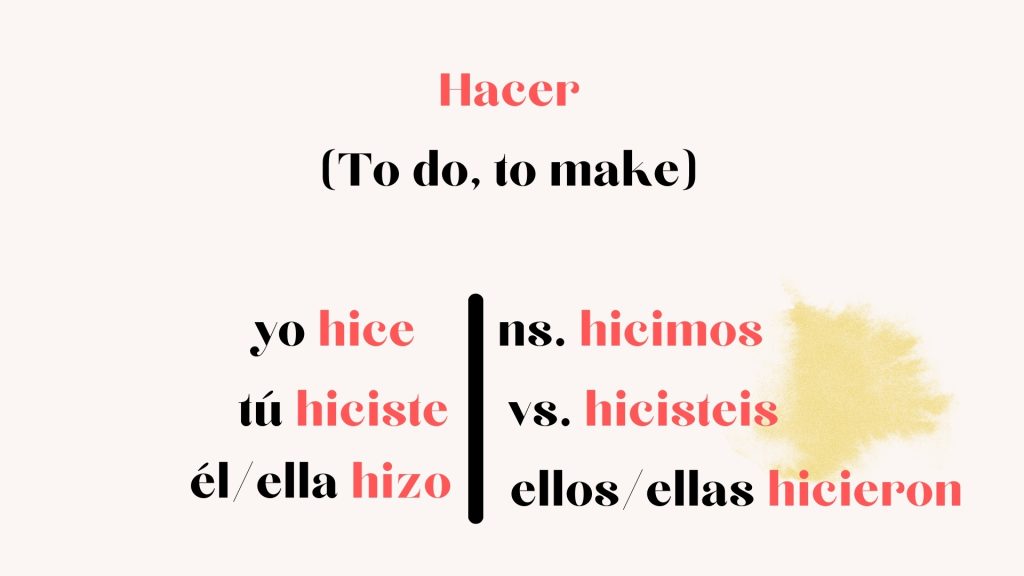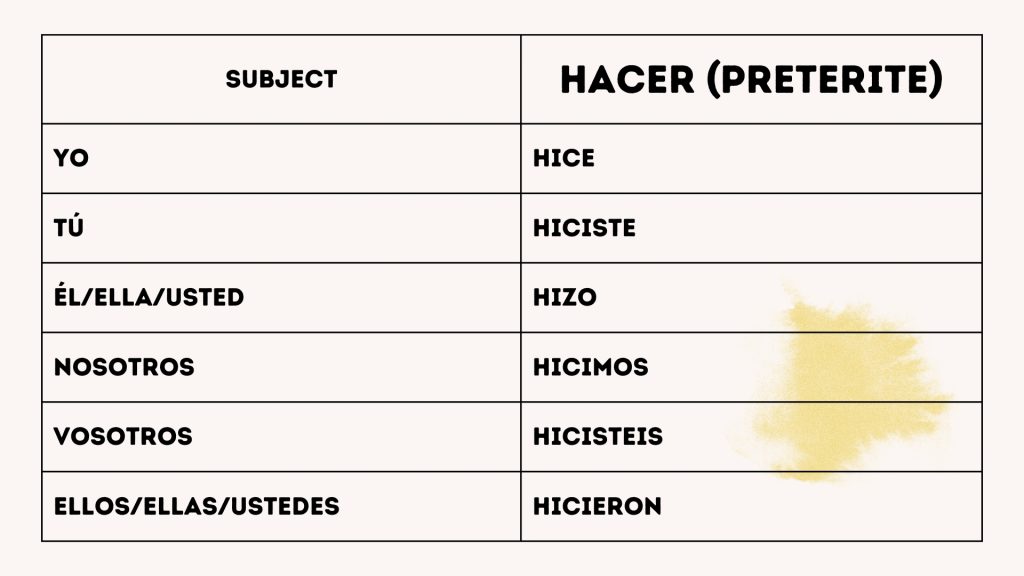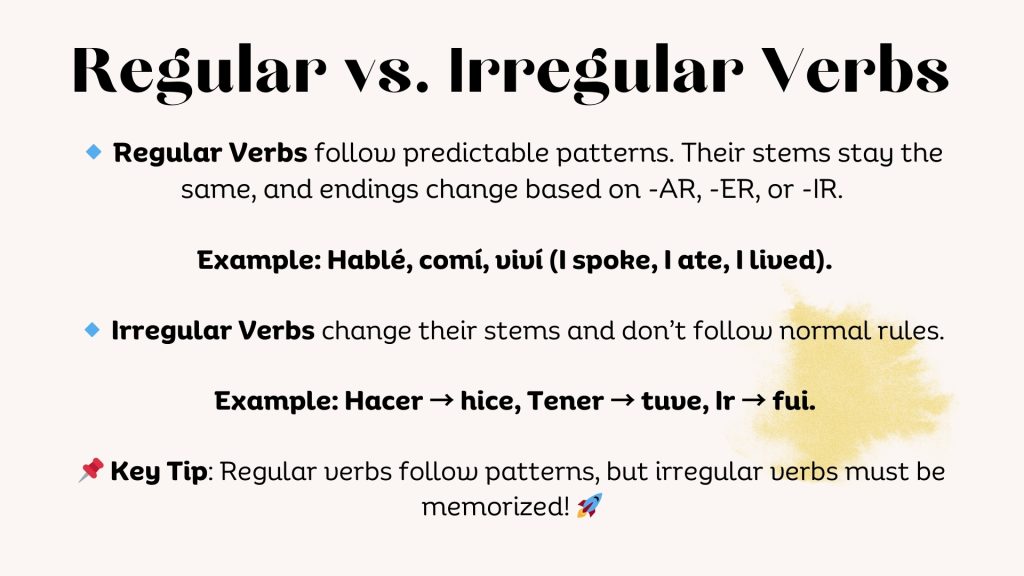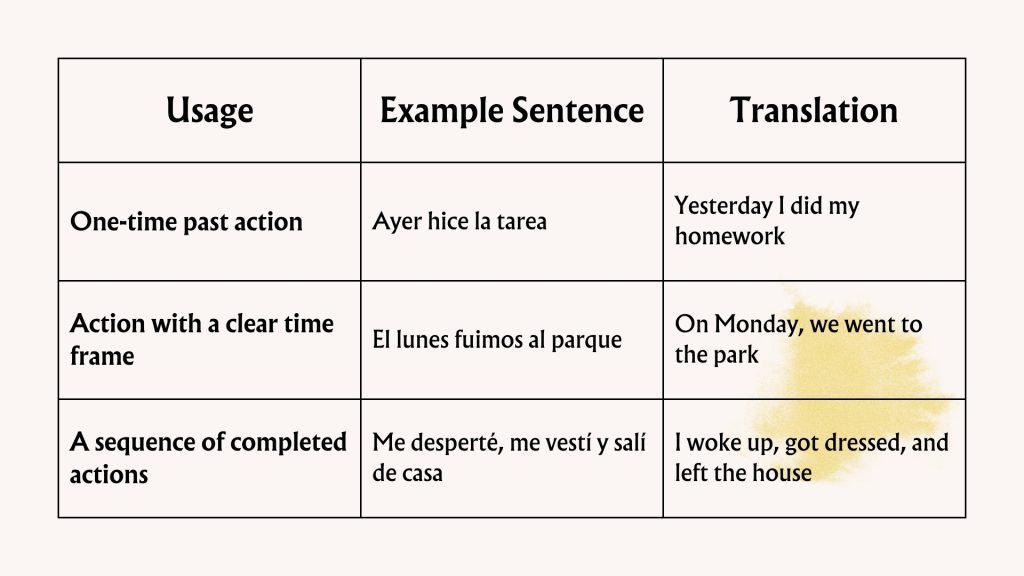Learning the preterite tense in Spanish is key to talking about past events clearly. A good preterite conjugation chart is essential. It shows how verbs change from their basic form into the past tense, covering both regular and irregular verbs. For example, the verb ‘hacer’ becomes ‘hice,’ ‘hiciste,’ ‘hizo,’ and so on. This helps you spot patterns and use them correctly when you’re speaking or writing.
Having such a chart makes understanding these verb changes easier and sets you up for tackling more complex grammar later. Getting good at this part of Spanish grammar really boosts your ability to communicate well in both writing and conversation.
Hacer Preterite Tense
The preterite form of the Spanish verb ‘hacer’ is irregular, making it a bit tricky to learn. It doesn’t follow the normal rules for past tense conjugation, which can throw off beginners. To use it correctly, you need to get familiar with its unique forms. Knowing how to conjugate ‘hacer’ properly is key for talking about past events clearly and correctly.
Hacer means “to do” or “to make” in Spanish. In the preterite, it changes its stem to hic-, except for the third-person form (hizo).

how to conjugate hacer in preterite tense
Conjugating the Spanish verb ‘hacer’ in the preterite tense means learning its unique forms, essential for talking about past events.

Here’s how it goes:
- I did is ‘yo hice,’
- you did is ‘tú hiciste,’
- he/she/it did is ‘él/ella/Ud. hizo,’
- we did is ‘nosotros hicimos,’
- you all did is ‘vosotros hicisteis,’
- and they did is ‘ellos/ellas/Uds. hicieron.’
These forms don’t follow the usual rules, so it’s important to memorize and practice them.
| Subject | Hacer (Preterite) |
|---|---|
| Yo | hice |
| Tú | hiciste |
| Él/Ella/Usted | hizo |
| Nosotros | hicimos |
| Vosotros | hicisteis |
| Ellos/Ellas/Ustedes | hicieron |
📌 Note: Hizo uses “z” to keep pronunciation smooth.
Hacer Participio
After looking at the preterite forms of ‘hacer’, let’s talk about its past participle, ‘hecho’.
We use ‘hecho’ in perfect tenses, like when you say ‘he hecho’ (I have done) or ‘había hecho’ (I had done).
| Tense | Example Sentence | Translation |
|---|---|---|
| Present Perfect | He hecho la tarea | I have done the homework |
| Past Perfect | Había hecho el café | I had made the coffee |
| Future Perfect | Habré hecho el informe | I will have done the report |
📌 Key Tip: Hecho is irregular—don’t say hacido (❌ wrong).
Hacer Imperfect Root
When learning how to use ‘hacer’ in the imperfect tense, it’s really about getting the hang of the root ‘hacía’. This root helps you build the forms to talk about regular or continuous past actions.
| Subject | Hacer (Imperfect) |
|---|---|
| Yo | hacía |
| Tú | hacías |
| Él/Ella/Usted | hacía |
| Nosotros | hacíamos |
| Vosotros | hacíais |
| Ellos/Ellas/Ustedes | hacían |
A Simple Guide to Conjugating IR Verbs in the Imperfect Tense!
Regular vs. Irregular Verbs
To get Spanish verb conjugation right, you need to know about regular and irregular verbs. Regular verbs are simple because they follow a set pattern. Once you know the pattern, you’re good to go.

But irregular verbs? They’re a different story. They don’t stick to the rules, so you have to remember how each one changes.
| Verb Type | Example Verb | Preterite Stem Change? |
|---|---|---|
| Regular | Comer → comí | ❌ No change |
| Regular | Hablar → hablé | ❌ No change |
| Irregular | Hacer → hice | ✅ Yes (hic-) |
| Irregular | Tener → tuve | ✅ Yes (tuv-) |
| Irregular | Venir → vine | ✅ Yes (vin-) |
📌 Irregular verbs don’t follow the normal -ar, -er, -ir patterns.
Learn Impactful Spanish Words Beginning with ‘R’.
Spanish Preterite Tense Conjugation Chart
The Spanish preterite tense chart helps you talk about things that happened in the past. It shows you how to change verb endings for different subjects, so you can say things correctly.

This chart is really handy, especially for tricky verbs like ‘hacer’. Using it, you can make sure you’re clear when you talk about things you’ve done before.
| Tense | Example Sentence | When to Use? |
|---|---|---|
| Preterite (Completed Action) | Ayer hice la cena | Something that happened once |
| Preterite (Specific Time) | El lunes hicimos un proyecto | A past action with a clear time |
| Imperfect (Ongoing Action) | Siempre hacía la cena | A repeated or ongoing past action |
📌 Rule of Thumb: If an action was one-time, specific, or finished, use preterite. If it was repeated or ongoing, use imperfect.
Conclusion
Learning how to conjugate the verb ‘hacer’ in the preterite tense is a big step in getting better at Spanish.
It’s really important to know the difference between regular and irregular verbs in the past tense if you want to communicate well.
With this knowledge, you’ll find yourself more fluent and confident, whether you’re writing or chatting in Spanish.
Master Any Language Easily with Lingua Viva Training!
Carolina is a charming and lively member of Lingua Viva with 11+ years of teaching experience. She loves to teach students appropriate ways to communicate effectively in Spanish without the fear of making mistakes. She holds a professional teaching license and has a graduate degree with emphasis in Foreign Language.











